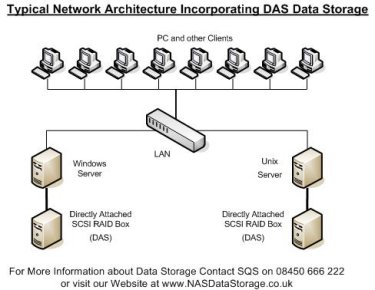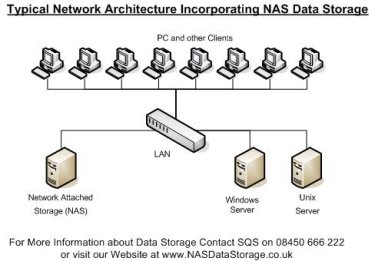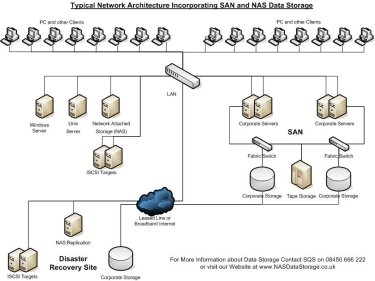A brief guide to data storage in modern network environments
Data storage requirements have changed massively over recent years and look set to continue to grow at a rapid rate for the foreseeable future.
Fortunately we have also seen equally rapid advances in hardware technology giving us ever higher capacity disks drives as well as faster network performance enabling us to move the data around our networks speedily. But with ever increasing data storage requirements, never before has it been so important to make sure that our networks grow with a strategy that will help us enable scalability, reliability, performance, availability, affordability and at the same time, manageability.
Direct attached Storage (DAS)
Traditionally data storage has been directly attached to a server, usually in the form of a collection of disks within a RAID chassis; this is then directly attached to the server typically using a SCSI or, in high demand Enterprise environments, sometimes Fibre Channel interface. Often the RAID being purchased at the same time as the server, this inextricably tied the server to the RAID and the particular file system used by that vendor. Whilst this approach solved the immediate storage requirement, when upgrades to servers and operating systems happen it is often difficult or impossible to guarantee that the original RAID will work as before with the new server or OS. This can mean that new data storage is required at the same time as the server is upgraded or that OS updates cannot be applied without first checking if our particular RAID box is supported. DAS is still a valid choice for Very high-end high-performance mainframe applications and certain computer intensive and high performance OLTP (Online Transaction Processing) database applications, but whilst this type of storage still holds advantages for some environments, its rigid connectivity makes it the choice for just these few and sales have now seen a shift to other more flexible solutions.

Network Attached Storage (NAS)
Network attached storage solves many of these problems by having much better connectivity, to the network this time and not directly to a server. By utilising a few commonly accepted networking file system standards (NFS or Network File System for the UNIX systems and CIFS or Common Internet File System, for the Windows family of operating systems); NAS devices are able to share data across networks covering almost every computer straight from the box.
The rise in NAS popularity has been largely helped by the increases in performance of the networks that distribute the data. Where as just a few years ago networks were limited by the 12.5MB/sec of a 10/100LAN, networks have now been given a new freedom, enjoying speeds of 128MB/sec with the new gigabit Ethernets and have 10GbE Ethernet to look forward to in the months to come. With these advances in network technology, the network is no longer the bottleneck it once was and NAS is seen as a near ideal solution for many environments, enjoying four main benefits.
- Simple installation and management for the organisation lowering costs.
- NAS utilises new faster gigabit network performance outstripping SCSI.
- The excellent connectivity and data sharing ability between heterogeneous clients.
- The ability to centralise data storage helping reduce costs whilst making it easier to secure the data and comply with numerous Acts.

So what is SAN?
SAN stands for Storage Area Network and is another architectural design for data storage on a corporate network. SAN networks take some advantages from Direct Attached Storage whilst retaining some advantages of the increased network performance. Data flow across the network is this time done at block level which has both advantages and disadvantages.
An advantage over NAS is that should a file change on the SAN only the portion of the file that has changed needs to be transferred father than the whole file, with the data being transported in a manner more akin to that seen in SCSI and other DAS systems. The SAN protocol ISCSI works by allocating a portion of the data storage to an individual server that controls the storage using an ISCSI Initiator. This method of addressing the storage allows protocols such as ISCSI to send SCSI commands over IP (and FIP which is similar but for fibre channel over IP) and this has immense benefits for the largest networks. Because the SCSI commands are now being sent over Ethernet the SCSI protocol has been freed from the 2M or so cable length limit allowing the server with an ISCSI initiator to communicate at block level with data storage hundreds of miles away and this has become ever more important for the large corporation since 11 th September and the roll of a distant disaster recovery site has been highlighted.

The largest SAN Networks are often best suited to homogenous networks where true file sharing is not a major requirement however and the benefits of the SAN are essential. Whilst a true SAN is sometimes the only option for large enterprise, for many quite sizeable networks it remains too expensive to purchase and maintain whilst delivering too few additional benefits over NAS to be a real consideration. That said, smaller ISCSI boxes are now available for midrange solutions and this brings many of the benefits of a SAN environment to smaller networks, without the disadvantage of the massive outlay once obligatory for such a solution.
For More Information
Call Us On 08450 666 222